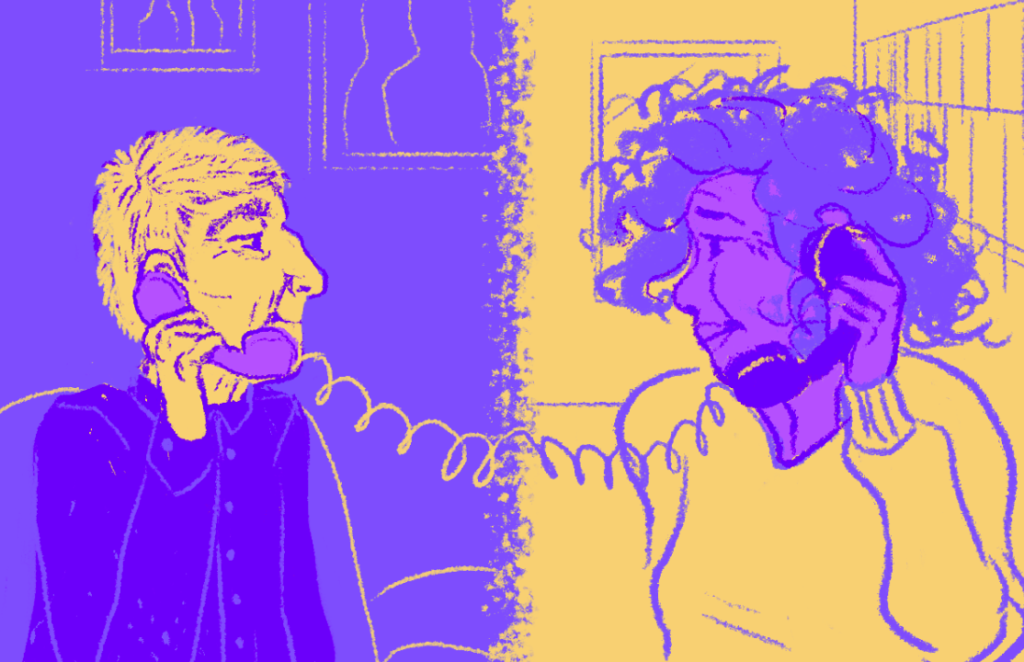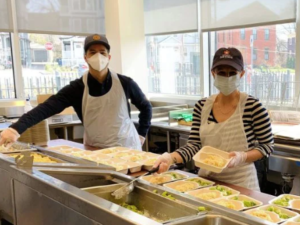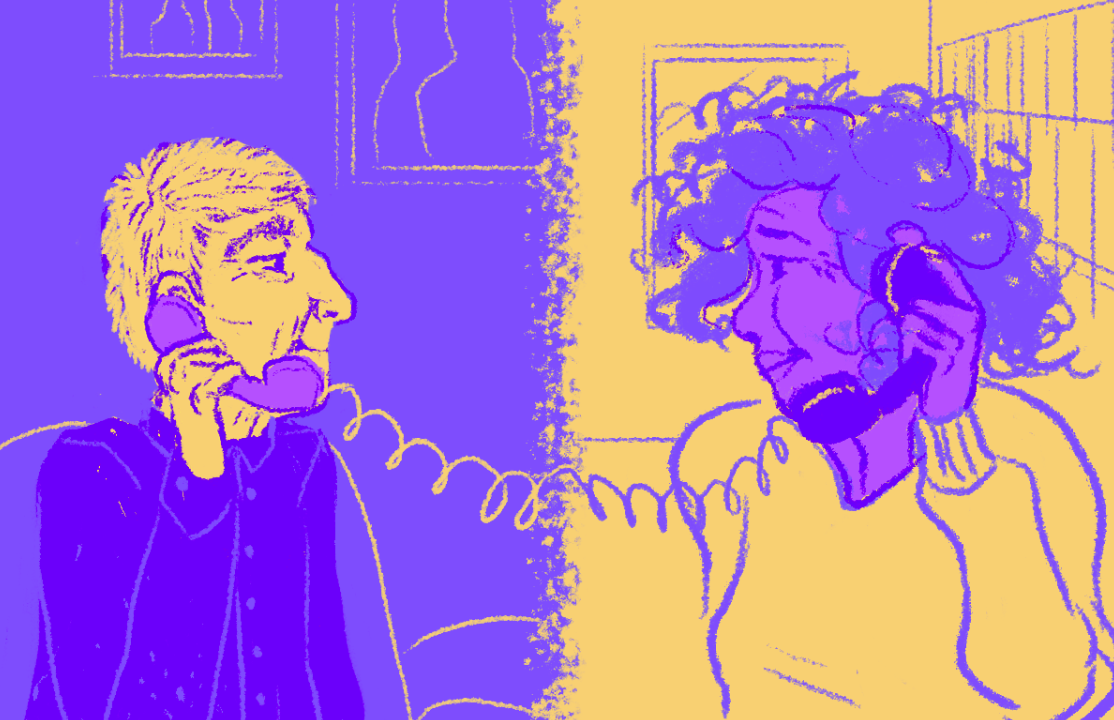by John-Manuel Andriote. This article originally appeared on Next Avenue.

Credit: Helen Teague
(Editor’s note: This story is part of Still Here, Still Positive: A series on the first generation of Americans aging with HIV/AIDS, with support from The John A. Hartford Foundation.)
Just as we gay and bisexual men measured our personal histories in relation to AIDS — starting in 1981 — everyone now speaks of the world, and our lives, “before” and “after” COVID-19.
Organizations created in the 1980s to serve very ill, homebound people with HIV/AIDS are demonstrating in this “after” that there is a greater-than-ever need for what they know about feeding and caring for people with life-challenging illness.
To get a picture of COVID-19 from the point of view of people whose work in local communities is rooted in caring for ill people in a pandemic, I checked in with some of the country’s leading service organizations created in the 1980s to serve people with AIDS.
What I found are organizations that pioneered volunteer-driven food programs and buddy services that today, in the midst of another public health crisis, are brilliantly demonstrating how to provide the strongest kind of social safety net — friends and neighbors, communities, caring for one another.
A Legacy of Love in Action
The word “legacy” came up a lot in these interviews. Each organization was founded across genders, often by one individual who brought friends along, and grew out of a simple sense of neighborly kindness.
Carrie Stoltzfus, executive director of Washington, D.C.’s Food & Friends, spoke about “the legacy of the amazing outpouring of love and generosity” that led a small group of volunteers in 1988 to begin preparing food in the kitchen of Westminster Presbyterian Church and deliver one meal a day, five days a week, to homebound people with AIDS.
“The moral and ethical leadership of those people in those early days…that’s what we stand on now,” Stoltzfus says, referring again to the legacy of the AIDS epidemic.
In 2020, Monday through Saturday, more than 8,000 volunteers help Food & Friends deliver free meals from its 11 specialized meal plans, medically tailored to meet clients’ specific nutritional needs. That includes the option of pureed or chopped foods and accommodations for special diets.
Only one in five clients today is living with HIV, thanks to reduced new infections and effective medical treatment that allows many HIV-positive people to live normal lifespans. Nearly half of Food & Friends’ clients are living with cancer; another third have other life-challenging illnesses such as heart or kidney failure.
With COVID-19 in the mix, even family caregivers are turning to Food & Friends’ services.
In the pre-COVID past, said Stoltzfus, a caregiver might be able to directly help their loved one with food and may not have been referred to Food & Friends based on the circumstances in the home. But now, caregivers may be self-isolating so as not to put the one they care for at risk.

Carrie Stoltzfus, of Washington, D.C.’s Food & Friends, ladling soup for delivery meals. (Credit: Food and Friends Facebook)
Sheltering-in-place during the COVID-19 pandemic has increased many people’s need for support who aren’t ordinarily homebound. While many of us have had a hard time getting used to spending so much time at home, community-based nutrition and buddy programs have been working hard to care for their clients who were already, or are newly, homebound.
Food & Friends and other nutrition agencies around the country have taken strenuous precautions to protect staff, volunteers, clients and, of course, the food through sanitation and disinfection. This includes changing staff schedules to reduce building traffic, control number of volunteers present at one time, moving operations outside, work spaces with six-foot markers, screening visitors and “dropping and knocking” rather than hand delivering meals.
Food Is Medicine
“Serving people in a pandemic is in our DNA,” said Leah Hébert Welles, executive director of Open Arms of Minnesota, in Minneapolis. “The need has never gone away for us.”
Founded in 1986, Open Arms’ staff dietitians, chefs and over 7,300 volunteers prepare and deliver more than 600,000 nutritious and free meals a year to people in the Twin Cities. Open Arms offers nine menus medically tailored to clients’ particular needs.
Welles told me in a telephone interview that HIV clients “have always gone off and on our services” as their health has waxed and waned. People living with HIV/AIDS today are referred to as “legacy clients” as the agency, like Food & Friends, serves clients with other life-limiting illnesses.
“In the early years,” said David Waters, CEO of Community Servings in Boston, “the establishment — whether it was the government, Reagan or public health — weren’t really stepping up. A lot of gay men invented the programs themselves.”
Community Servings was created in 1990 after a group of HIV-positive gay Jewish men went to the American Jewish Congress and said Boston’s Jewish community wasn’t doing enough to address HIV/AIDS. Seventy different groups — including AIDS activists, faith groups and community organizations — joined forces to create the agency.
From delivering hot meals to 30 clients in the Roxbury and Dorchester sections of Boston, Community Servings today serves thousands of people in Massachusetts who are unable to shop or cook for themselves because of illness. It offers 15 menus tailored to clients’ medical needs. All of the food is locally sourced and made from scratch. Depending on a client’s illness, Waters said, menus can be “cross-prescribed” —different diets for multiple health conditions addressed in the same meal in a way that mimics a prescription.
Like so many who stepped up in the early AIDS years before effective treatment, Waters, a former restaurateur and caterer, went to work for the agency because he could help with fundraising “and it was a way for me personally to cope with my own fear of the virus.”
Demand for the agency’s services is increasing in the COVID-19 pandemic.

Community Servings volunteers keep a distance of six feet, wear face masks, must sanitize their hands upon entry and have their temperature taken. (Credit: Community Servings Facebook)
“We’re getting a lot of calls,” said Waters, “and I think we’ll get even more in the near-term. We’re certainly ramping up with the expectation that there’ll be more people to be fed — both those who may be positive for the virus, but also those who have lost their jobs and are very isolated and don’t have the money.”
That the work is no longer about serving only gay men or HIV-positive people is beside the point; it’s all about applying what was learned in the AIDS pandemic to meet the bigger needs of the larger community. Besides, as effective treatment lets people age with HIV, the lines blur as to whether someone’s need is defined by chronological age, HIV status or another of the chronic health conditions that frequently affect older people.
“I sometimes say I came to this to care for my own,” said Waters. “And then I just kept realizing that what I called ‘my own’ was bigger and bigger, from feeding gay men to feeding people of color, to feeding people with other illnesses and feeding mothers with children. You just realize that they’re all very artificial distinctions.”
Making Room at the Table
I reported for The Washington Post in 2000 about Food & Friends’ expanded mission to serve more people than only those living with HIV. The organization’s decision to assist people with life-threatening illnesses in the Washington, D.C. area was a controversial step at the time. The gay community that had given rise to, and raised lots of money for, the agency was concerned that those “legacy” HIV/AIDS clients would be shortchanged.
Back then, it was only possible to think about serving others because, beginning with the 1996 advent of combination therapy, people were starting to live with HIV rather than almost inevitably die from AIDS. It was certainly good news for people with HIV, but it meant the organizations created to serve them had the capacity to serve more people than those with HIV who no longer needed their support.
As Food & Friends’ former executive director Craig Shniderman said at the time, “If our mission is to serve people who are profoundly ill, and we are adequately serving those we have as clients and have excess capacity, isn’t there a duty to serve others?”
Open Hand Atlanta — founded in 1988 when Michael Edwards-Pruitt rounded up his neighbors to help cook and deliver meals to 14 friends dying from AIDS who were too sick to cook for themselves — also expanded its mission in 2000 to serve people with other critical illnesses, plus those living with disabilities and homebound elders. Its $500-per-month grocery bill in 1989 is now over $85,000 a week. Each day, the agency prepares, packs and delivers nearly 5,000 meals for people with HIV and people battling cancer, heart disease, renal failure, diabetes or other “nutrition-sensitive” diseases.
The expanded mission has likewise expanded the range of funders who support Open Hand Atlanta and other nutrition agencies like it in other cities. This is important for groups that have to raise all their money — and already faced a growing caseload even before COVID-19.
Working through the Food Is Medicine Coalition, these nutrition agencies advocate in Washington, D.C. to persuade federal funders to cover the relatively modest cost — relative to the cost of acute medical care, that is — of medically tailored nutrition for people whose condition warrants a specific diet.
Matthew Pieper, Open Hand Atlanta’s executive director, says the Food Is Medicine organizations are uniquely positioned to work with health plans and managed care plans willing to reimburse them for their services.
Food is far more than something to satisfy hunger pangs.
“It’s actually a tool all of us can use to better prevent or manage chronic disease,” said Pieper. “Food is medicine, but food is also love, and I think right now in this COVID-19 pandemic, that packaging up and delivering a meal for someone is still a profound way to say you’re cared about, your community has not forgotten about you. It’s a way we can show love.”
A Brave New World for Buddies
When New York City’s HIV/AIDS service organization GMHC (formerly known as the Gay Men’s Health Crisis) revived its buddy program in 2015, no one had any idea how vitally important it would become five years later as clients were forced to stay in because of COVID-19.
GMHC created the buddy program in 1982, one of the world’s first AIDS service organization’s first services. Back then, volunteer buddies visited and called their client, provided practical assistance and really helped people with AIDS know they were not alone. The program had stopped in 2005 when effective treatment meant there were far fewer seriously ill clients and a far greater need to help HIV-positive clients prepare to return to the workforce. But over the years it had become clear that too many long-term HIV survivors — those diagnosed before 1996 — were becoming depressed and isolated, some to the point they stopped taking their medications.

Susan Rowley, who runs GMHC’s buddy program after managing its hotline since 1995. (Photo courtesy of GMHC)
Susan Rowley, a former lawyer and licensed social worker, runs GMHC’s buddy program after managing the agency’s hotline since 1995. She says most of GMHC’s buddy program clients were mobile before COVID-19 forced them to become homebound.
Required isolation presents a challenge for a program whose purpose is to foster connection, but GMHC’s buddies are staying connected with their clients via phone calls and texts.
Rowley said that while buddies are expected to reach out at least weekly to their clients, “people are staying in touch daily just to let them know someone is there.”
Buddies are now also beginning to meet for the first time in Zoom video meetings.
“I don’t think it works for everyone, and I don’t think it’s necessarily what people need,” says Rowley. “It may be the only way to work with a client, and we’ll work with it. But we know that getting out of the house is critical. Even if it’s for a cup of coffee — that one-on-one interaction helps people.”
Much like GMHC’s buddy program, the Friendly Visitor program at New York City-based LGBTQ elder advocacy nonprofit SAGE provides social support to elders who may be homebound and are often living with HIV or other health challenges. Friendly Visitor volunteers traditionally have visited clients once a week for an hour or two and made calls between visits. Sometimes, that has involved picking up groceries or prescriptions; other times it may be helping with such tasks as sorting mail or navigating the internet.
Although SAGE on March 15 put in-person visits on hold, volunteers have kept in touch with their Friends at Home, as clients are known. “One of our volunteers just a week before had helped his client get an iPad, and so the two of them have been having daily Skype sessions,” said Friendly Visitor program manager Bill Gross, who also ran GMHC’s buddy program 20 years ago.
Gross predicted that even after COVID-19, more Friendly Visitor check-ins will be conducted by Skype or Zoom. Friendly Visitors also are using phone calls and email to stay in touch, and middle-school students are creating postcards the program will use to connect with its Friends at Home.

Friendly Visitor program manager Bill Gross, who also ran GMHC’s buddy program 20 years ago. (Photo courtesy of Bill Gross)
In response to the coronavirus, SAGE has also launched SAGEConnect — a phone service where LGBTQ elders are matched with volunteers for weekly phone calls for six weeks. (Next Avenue Influencer in Aging Michael Adams, CEO of SAGE, wrote about SAGEConnect in his recent article, “Individual Heroism Propels LGBTQ Elders in COVID-19.”)
Stepping Into the Health Care Void
Forced to fend for ourselves as HIV/AIDS struck down tens of thousands, our community had to create our own service organizations.
We learned how to channel our love, power and resilience through organizations like Food & Friends, Open Arms, Community Servings, Open Hand Atlanta, GMHC and SAGE.
Today those organizations, created in the depths of a deadly pandemic that has continued for nearly 40 years, are not only rising to the new challenges of another pandemic but are demonstrating how to provide excellent, cost-effective care and support for people who are homebound — whether due to age-related debilitation, illness or shelter-in-place orders.
Amy Knowlton, a professor at Johns Hopkins Bloomberg School of Public Health in Baltimore, researches how people are connected in communities and how diseases happen within networks. Her work focuses on how people take care of one another, particularly those with limited resources.
“Unless we really take seriously how people are connected, the important relationships they have, how infections are transmitted as well as how support and care operates, we’re just not going to be able to have a meaningful impact on pandemics,” Knowlton said.
“Informal caregivers” — family members, friends, neighbors, community-based organizations — are “the only safety net we have,” she noted.
Informal caregivers are ones who mainly tend to the long-term needs that are “mostly ignored by the health care system.”
While AIDS brought about what Knowlton described as “a phenomenal galvanizing of communities and demonstrating what communities have to do for themselves,” volunteer-focused agencies that must raise the volunteer corps (as well as every dollar it costs to provide free services) can’t do the job without bigger support.
Knowlton said public resources must be invested in helping “to facilitate communities’ capacity for helping themselves and each other.”
As the live-in caregiver for my late mom until her passing last fall at 84, as the recipient of support from my own HIV case manager and others and as a longtime chronicler of the HIV/AIDS pandemic, I can attest to the essential role of informal caregivers and nonprofit organizations in plugging the gaping holes in our health care system.
I’ve spent a career documenting the extraordinary outpouring of caring, community and connectedness generated by HIV/AIDS because I believe it provides the absolute best homegrown solutions for serving America’s booming population of elders and those with health conditions that prevent them from being able to care for themselves.
“We need a public health care system that recognizes and strengthens supportive relationships across the lifespan and ensures their resources for meaningful assistance in everyday coping as well as in managing health problems,” Knowlton said. “Such a holistic approach recognizes that mind, body and relationships are integrally linked and important to tend to for truly promoting health and well-being.”
In other words: a health care system that the pioneering organizations profiled here have envisioned for decades and worked to bring about. Responding to AIDS taught them what is needed and how to provide it. COVID-19 is proving again how visionary, and necessary, they will continue to be going forward. As Knowlton put it, “COVID-19 is going to be a wake-up call in so many ways.”
The opinions expressed in this article are those of the author and do not necessarily reflect those of the Diverse Elders Coalition.


